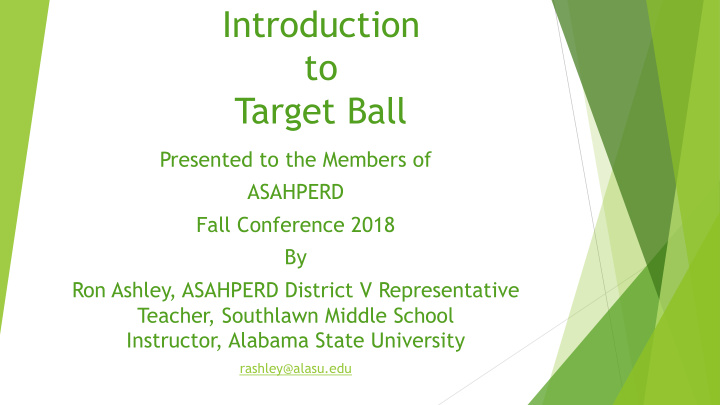



Introduction to Target Ball Presented to the Members of ASAHPERD Fall Conference 2018 By Ron Ashley, ASAHPERD District V Representative Teacher, Southlawn Middle School Instructor, Alabama State University rashley@alasu.edu
Thank You u Thank you very much for participating in this session and for attending this conference. u I respectfully invite each of you to seriously consider becoming an active member of the ASAHPERD Board now or in the very near future. u Every District need your support and service.
Introduction u Target Ball is a fun, fast pace game suitable for both indoors and outdoors. u The modifications and variations which can be made to the game will vary based on age, skill level, space and number of participants. u Target ball is played using a modification of regulation basketball rules. u When space is available it can be played on a regulation basketball court: full court or two games playing cross court to allow greater student participation.
Game Differences u Several of the biggest differences in the game are: u The game is played using a form ball therefore, no dribbling is allowed. u Objective 1: To force offensive players to learn to move without the ball and create passing lanes. u Objective 2: Teach the ball hander to look for the open pass first and make accurate passes.
Game Differences u Ball handler cannot run with the ball. Once he/ she catches the ball only the pivot foot can be moved. u Maximum of five (5) seconds to pass the ball or throw at the target ball. u Dropped passes or hand-offs results in a turn-over. The opponent inbound the ball at the spot of the drop. u Traveling results in a turn-over.
Scoring u Points are scores by throwing the game ball at one of three foam balls sitting on top of three cones located on the court end line. u Each ball knocked off the cone is worth two(2) points. u First team to score six (6) points wins the game or the team leading in points at the end of the timed game is the winner.
Notes
Scoring u Scoring: Initial teaching of the game to promote scoring and built confidence and excitement scoring is allowed by: 1. the ball hitting the cone and knocking the target ball off. 2. the ball bouncing off the floor and hitting the cone or target ball or both. 3. After skill level improves scoring is only allowed by a direct hit from the thrown ball to the target ball.
Boundaries u The permanent lines on the court or boundaries you establish with markers, cones, tape, etc. u Turn-overs are inbound as close to the spot where the turn-over occurred. u Five second throw-in count. u Restraining line:(Like the free throw lane) Cones work better because they provide a visual barrier for the participants. u All throws at the target ball must come in front of the restraining line (cones).
Fouls u Normal basketball player fouls are called. u An imposed foul results in an inbound of the ball by the opposing team at the spot of the foul. u Technical or flagrant fouls will result in two free throws at the target ball and u The offending player removed from the game.
Player Position u CENTER u FORWARD FORWARD u GUARD GUARD u The center may also serve as the goalie however, he/she must remain in front of the restraining line/cones.
Equipment u Playing Area u Cones u Foam Balls u Color jerseys u Timer u Whistle
Skill Level/Game Knowledge u Sixth graders and below or skill level and game knowledge of participants may require a few more players on the court for each team as space permits.
Balance u Target ball neutralizes the physical talents of individuals and force everyone to play team ball to be successful. u At the upper middle school/high school level males and females play the game very competitive on mixed teams. u Successful teams learn which players have the best talent for each position on the court.
Recommend
More recommend